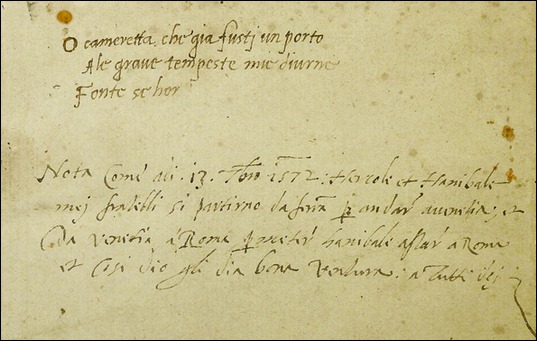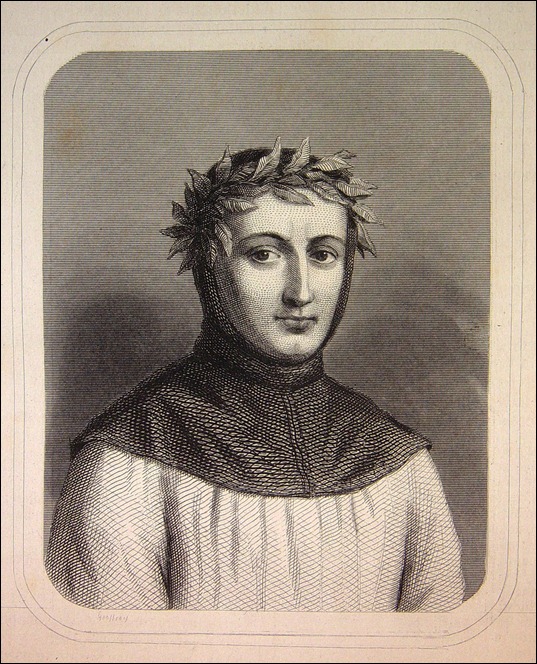Adjective Order in Italian Posted by Serena on Jul 2, 2014 in Grammar
Dear readers, your questions really do help us to focus on what’s important to you as students of Italian, so please keep them coming. Here’s an interesting one that arrived a few days ago from a reader called Patsy:
“Could you give me any advice on adjective order in the case of multiple adjectives? It doesn’t sound right to just say the adjectives together as you would in English and sounds better if one goes before the noun and one after but I’m not sure why or what the rule is.”
When I read this question, my mind immediately went to one of Francesco Petrarca’s most famous poems which starts with the following words:
“Chiare, fresche et dolci acque,
ove le belle membra
pose colei che sola a me par donna”
“Chiare, fresche e dolci acque,
dove immerse le belle membra
colei che unica sembra degna di essere la mia signora”
“Clear, fresh and sweet waters,
in which the only one who seems to me to deserve to be my lady
immersed her beautiful limbs”
The opening line of Petrarca’s Canzone 126, written around 1340, clearly shows that it’s normal to put several adjectives in a row in Italian. In this particular case, the fact that all the adjectives are positioned before the noun acque (waters) signifies that they are all equal in importance. Let’s see what happens if we reposition one of adjectives, fresche, after the noun acque. In this case we have: “chiare e dolci acque fresche” (Sorry, Francesco, no offence meant!). But by putting the adjective fresche after the noun acque we give it a greater emphasis, and therefore imply that it’s fundamental to the understanding of the noun. Acque fresche means that the waters are intrinsically fresh, and the fact that they are “chiare e dolci” (clear and sweet) is just lesser detail that could be omitted.
 |
| Early ms. transcription of the first few lines of Francesco Petrarca’s sonnet “O cameretta che già fosti un porto”Photo (CC) kladcat |
However, this is only valid for adjectives that belong in the same category. In the above case chiare, fresche, and dolci are all aggettivi qualificativi (qualifying adjectives*). If we mix different types of adjectives, then there are some rules to follow:
aggettivi dimostrativi (demonstrative adjectives*), i.e. questo (this), and quello (that), go in front of any other adjective, e.g. Come si chiama questo piccolo paese? (What’s the name of this little village?); mi piace quella vecchia casa lì (I like that old house over there)
aggettivi possessivi (possessives adjectives*), i.e. mio (my), tuo (your, sing.), suo (his/her), nostro (our), vostro (your, plural) and loro (their) go in front of the noun, but after questo and quello, e.g. quando è cominciata questa tua passione per gli aerei? (when did this passion of yours for aeroplanes begin?); mi dà tanto fastidio quella sua abitudine di mangiarsi le unghie (I really dislike that habit of his of biting his nails)
Then there are adjectives which always follow the noun, such as colours and nationalities, e.g. ti piace questo maglione rosso? (do you like this red jumper?), Lucia è laureata in letteratura francese (Lucia ha a degree in French literature).
For a complete list of types of adjectives and their position you can refer to this post: adjectives and their position
Spero che queste mie poche semplici righe vi siano utili!

Build vocabulary, practice pronunciation, and more with Transparent Language Online. Available anytime, anywhere, on any device.





Comments:
Guest:
Ciao Serena, Geoff,
Qual è la regola per l’aggettivo ‘scorso’? Trovo altrettanto spesso prima e dopo il sostantivo, ad esempio: l’anno scorso e lo scorso anno. Qual è la differenza?
Saluti,
Gery
Serena:
@Guest Ciao Gery, ti risponderò nel blog di lunedì prossimo!
A presto
Serena
P.S. sei Gery di Latina?
Jack Perry:
Possessive pronouns/adjectives can be placed after the noun: “il mio amore” & “l’amore mio,” for example. In fact, you’re more likely to hear the second than the first.
Serena:
@Jack Perry Salve Jack, did you learn your Italian from the Sopranos?
You wrote: “Possessive pronouns/adjectives can be placed after the noun: “il mio amore” & “l’amore mio,” for example. In fact, you’re more likely to hear the second than the first”
My Italian grammar book (Grammatica Italiana, by S.Battaglia e V.Pernicone), which I used when I studied Lettere Classiche at the Università di Pisa, states:
“Di solito l’aggettivo possessivo precede il nome a cui si riferisce. Più rara è la costruzione con il possessivo posposto al nome … In questo caso il possessivo acquista un rilievo maggiore. Anzi nelle espressioni vocative ed esclamative il possessivo della prima e seconda persona (tanto singolare, mio e tuo, quanto plurale, nostro e vostro) si pospone sempre: Figlio mio, anima mia, O patria nostra, Dio mio! Mamma mia!”
I’m sure you won’t have any problem to read and understand this explanation given your great knowledge of the Italian language 😉
Saluti da Serena
P.S. possessive pronouns, and pronouns in general, cannot be placed after the noun they refer to because they substitute the noun, that’s why they are called “pronouns”!
Griffin Lichtenson:
Ciao. Can you guys do a post on how to ask for directions in Italia for various situations; like buses, monuments, sites, etc. Maybe also some practical socializing tips for ordering at restaurants to impress Italians hosts and blend in instead of being the typical tourist reading from a pocket language book. I plan to andro in Roma in Maggio so advice is always great for college students like me
Great posts by the way.
Griffin
Geoff:
@Griffin Lichtenson Salve Griffin, wow, you want all of that in one post 🙂
Here are three old blogs to get you started:
https://blogs.transparent.com/italian/mezzi-di-trasporto-1/
https://blogs.transparent.com/italian/mezzi-di-trasporto-2/
https://blogs.transparent.com/italian/mezzi-di-trasporto-3/
Well write something specific on asking directions soon, then we’ll have a look at the restaurant thing, va bene.
Grazie per il suggerimento, a presto, Geoff